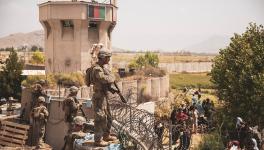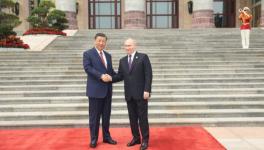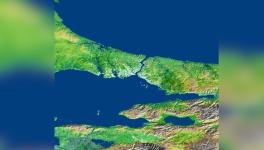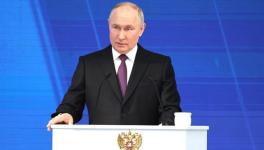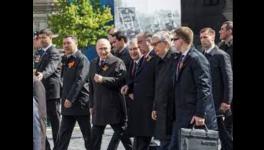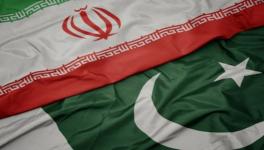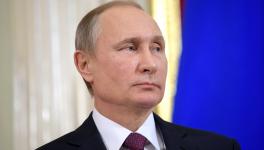How the Taliban Chased the West out of Afghanistan

Secretary of State Michael R. Pompeo meets with the Taliban Negotiation Team, in Doha, Qatar, on November 21, 2020. Photo: Ron Przysucha / State Department
Days after the Taliban drove into Kabul on August 15, its representatives started making inquiries about the “location of assets” of the central bank of the nation, Da Afghanistan Bank (DAB), which are known to total about $9 billion. Meanwhile, the central bank in neighboring Uzbekistan, which has an almost equivalent population of approximately 34 million people compared to Afghanistan’s population of more than 39 million, has international reserves worth $35 billion. Afghanistan is a poor country, by comparison, and its resources have been devastated by war and occupation.
The DAB officials told the Taliban that the $9 billion are in the Federal Reserve in New York, which means that Afghanistan’s wealth is sitting in a bank in the United States. But before the Taliban could even try to access the money, the US Treasury Department has already gone ahead and frozen the DAB assets and prevented its transfer into Taliban control.
The International Monetary Fund (IMF) had recently allocated $650 billion Special Drawing Rights (SDR) for disbursement around the world. When asked if Afghanistan would be able to access its share of the SDRs, an IMF spokesperson said in an email, “As is always the case, the IMF is guided by the views of the international community. There is currently a lack of clarity within the international community regarding recognition of a government in Afghanistan, as a consequence of which the country cannot access SDRs or other IMF resources.”
Financial bridges into Afghanistan, to tide the country over during the 20 years of war and devastation, have slowly collapsed. The IMF decided to withhold transfer of $370 million before the Taliban entered Kabul, and now commercial banks and Western Union have suspended money transfers into Afghanistan. Afghanistan’s currency, the Afghani, is in a state of free fall.
When aid vanishes
Over the last decade, Afghanistan’s formal economy struggled to stay afloat. Since the US-NATO invasion of October 2001, Afghanistan’s government has relied on financial aid flows to support its economy. Due to these funds and strong agricultural growth, Afghanistan experienced an average annual growth rate of 9.4 percent between 2003 and 2012, according to the World Bank. These figures do not include two important facts: first, that large parts of Afghanistan were not in government control (including border posts where taxes are levied), and second, that the illicit drug (opium, heroin, and methamphetamine) trade is not counted in these figures. In 2019, the total income from the opium trade in Afghanistan was between $1.2 billion and $2.1 billion, according to the United Nations Office on Drugs and Crime (UNODC). “The gross income from opiates exceeded the value of the country’s officially recorded licit exports in 2019,” stated a February 2021 UNODC report.
During the past decade, aid flow into Afghanistan has collapsed “from around 100 percent of GDP in 2009 to 42.9 percent of GDP in 2020.” The official economic growth rate between 2015 and 2020 fell to 2.5 percent. The prospects for an increase in aid seemed dire in 2020. At the 2020 Afghanistan Conference, held in Geneva in November, the donors decided to provide annual disbursements rather than aid in four-year packages. This meant that the Afghan government would not be able to sufficiently plan their operations. Before the Taliban took Kabul, Afghanistan had begun to recede from the memory of those countries that had invaded it in 2001-2002.
A country of poverty
During the past 20 years, the United States government spent $2.26 trillion toward its war and occupation of Afghanistan. European countries spent nothing close to what the United States spent (Germany spent $19.3 billion by the end of 2018, of which $14.1 billion was to pay for the deployment of the German armed forces).
The money coming from all the donors into Afghanistan’s burgeoning aid economy had some impact on the social lives of the Afghans. Conversations with officials in Kabul over the years are sprinkled with data about increased access to schools and sanitation, improvements in the health of children and greater numbers of women in Afghanistan’s civil service. But it was always difficult to believe the numbers.
In 2016, Education Minister Assadullah Hanif Balkhi said that only 6 million Afghan children attended the country’s 17,000 schools, and not 11 million as reported earlier (41 percent of Afghanistan’s schools do not have buildings). As a result of the failure to provide schools, the Afghan Ministry of Education reports that the total literacy rate in the country was 43 percent in 2020, with 55 percent being the literacy rate for men and 29.8 percent being the literacy rate for women. Donors, aid agencies, and the central government officials produced a culture of inflating expectations to encourage optimism and the transfer of more funds. But little of it was true.
Meanwhile, it is shocking to note that there was barely any construction of infrastructure to advance basic needs during these 20 years. Afghanistan’s power company—Da Afghanistan Breshna Sherkat (DABS)—reports that only 35 percent of the population has access to electricity and that 70 percent of the power is imported at inflated rates.
Half of Afghanistan lives in poverty, 14 million Afghans are food insecure, and 2 million Afghan children are severely hungry. The roaring sound of hunger was combined—during these past 20 years—with the roaring sound of bombers. This is what the occupation looked like from the ground.
The Taliban’s anti-corruption crusade
In a 2013 New York Times article, a US official said, “The biggest source of corruption in Afghanistan was the United States.” Dollars flowed into the country in trunks to be doled out to politicians to buy their loyalty. Contracts to build a new Afghanistan were given freely to US businessmen, many of whom charged fees that were higher than their expenditure inside Afghanistan.
Afghanistan’s President Ashraf Ghani, who fled into exile hours before the Taliban took control of Kabul, took office making a lot of noise about ending corruption. When he fled the country, press secretary of the Russian embassy in Kabul Nikita Ishchenko told RIA Novosti, his people drove four cars filled with money to the airfield. “They tried to stuff another part of the money into a helicopter, but not all of it fit. And some of the money was left lying on the tarmac,” according to a Reuters report. Corruption at the top spilled down to everyday life. Afghans reported paying bribes worth $2.25 billion in 2020—37 percent higher than in 2018.
Part of the reason for the Taliban’s rapid advance across Afghanistan over the course of the past decade lies in the failure of the US-NATO-backed governments of both Hamid Karzai (2001-2014) and Ashraf Ghani (2014-2021) to improve the situation for Afghans. Surveys regularly found Afghans saying that they believed corruption levels were lower in Taliban areas; similarly, Afghans reported that the Taliban would run schools more effectively. Within Afghanistan, the Taliban portrayed themselves as more efficient and less corrupt administrators.
None of this should allow anyone to assume that the Taliban have become moderate. Their agenda regarding women is identical to what it was at its founding in 1994. In 1996, the Taliban drove into Kabul with the same argument: they would end the civil war between the mujahideen, and they would end corruption and inefficiency. The West had 20 years to advance the cause of social development in Afghanistan. Its failure opened the door for the return of the Taliban.
The United States has begun to cut off Afghanistan from its own money in US banks and from financial networks. It will use these means to isolate the Taliban. Perhaps this is a means to force the Taliban into a national government with former members of the Karzai-Ghani governments. Otherwise, these tactics are plainly vindictive and will only backfire against the West.
Vijay Prashad is an Indian historian, editor and journalist. He is a writing fellow and chief correspondent at Globetrotter. He is the chief editor of LeftWord Books and the director of Tricontinental: Institute for Social Research. He is a senior non-resident fellow at Chongyang Institute for Financial Studies, Renmin University of China. He has written more than 20 books, including The Darker Nations and The Poorer Nations. His latest book is Washington Bullets, with an introduction by Evo Morales Ayma.
This article was produced by Globetrotter.
Get the latest reports & analysis with people's perspective on Protests, movements & deep analytical videos, discussions of the current affairs in your Telegram app. Subscribe to NewsClick's Telegram channel & get Real-Time updates on stories, as they get published on our website.










